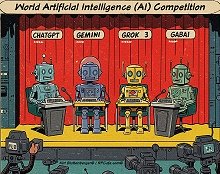Electronics & Technology
- See Full List of AI Topics -
Loran (short for Long Range Navigation) is a radio-based navigation system
that was developed in the early 1940s for use by the military during World War
II. The system uses radio signals to determine a location and was primarily used
by ships and aircraft.
The development of Loran began in the United States in the early 1940s, with
the goal of creating a navigation system that could be used by the military to
accurately determine a ship or aircraft's position over long distances, even in
adverse weather conditions. The first Loran system was called Loran A and was
developed by the US Coast Guard in collaboration with the Massachusetts
Institute of Technology (MIT) and the Radio Corporation of America (RCA).
Loran A was first used by the US military in 1942 and was later adopted by
the British and Canadian militaries as well. The system used two or more fixed
ground stations that transmitted synchronized pulses of radio waves, which were
received and measured by a Loran receiver on board the ship or aircraft. By
measuring the time difference between the received pulses, the Loran receiver
could calculate the distance to each of the ground stations and then use
triangulation to determine the user's position.
In the 1950s, Loran B was developed, which used more advanced technology to
improve the accuracy of the system. Loran C, the most widely used version of the
system, was developed in the 1960s and provided even greater accuracy and
coverage. Loran C was used extensively by the military and by civilian ships and
aircraft for many years.
With the development of more advanced navigation systems, such as GPS (Global
Positioning System), the use of Loran has declined. Loran C was officially
decommissioned in 2010 in the United States, and many other countries have also
discontinued their Loran systems.
Despite the decline of Loran, its development and evolution played a
significant role in the advancement of radio-based navigation systems and helped
pave the way for more advanced systems like GPS.
 This content was generated by primarily
the ChatGPT (OpenAI), and/or
Gemini (Google), and/or
Arya (GabAI), and/or
Grok (x.AI), and/or DeepSeek artificial intelligence (AI) engine.
Some review was performed to help detect and correct any inaccuracies; however,
you are encouraged to verify the information yourself if it will be used for critical
applications. In some cases, multiple solicitations to the AI engine(s) was(were) used to assimilate
final content. Images and external hyperlinks have also been added occasionally.
Courts have ruled that AI-generated content is not subject to copyright restrictions,
but since I modify them, everything here is protected by RF Cafe copyright. Many
of the images are likewise generated and modified. Your use of this data implies
an agreement to hold totally harmless Kirt Blattenberger, RF Cafe, and any and all
of its assigns. Thank you. Here are the major categories. This content was generated by primarily
the ChatGPT (OpenAI), and/or
Gemini (Google), and/or
Arya (GabAI), and/or
Grok (x.AI), and/or DeepSeek artificial intelligence (AI) engine.
Some review was performed to help detect and correct any inaccuracies; however,
you are encouraged to verify the information yourself if it will be used for critical
applications. In some cases, multiple solicitations to the AI engine(s) was(were) used to assimilate
final content. Images and external hyperlinks have also been added occasionally.
Courts have ruled that AI-generated content is not subject to copyright restrictions,
but since I modify them, everything here is protected by RF Cafe copyright. Many
of the images are likewise generated and modified. Your use of this data implies
an agreement to hold totally harmless Kirt Blattenberger, RF Cafe, and any and all
of its assigns. Thank you. Here are the major categories.
Electronics & High Tech
Companies | Electronics &
Tech Publications | Electronics &
Tech Pioneers | Electronics &
Tech Principles |
Tech Standards Groups &
Industry Associations | Societal
Influences on Technology
|








